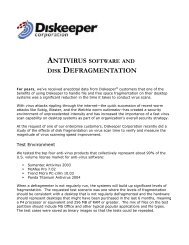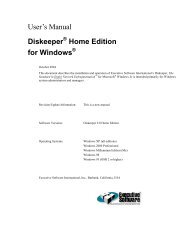Diskeeper 10 User's Manual
Diskeeper 10 User's Manual
Diskeeper 10 User's Manual
You also want an ePaper? Increase the reach of your titles
YUMPU automatically turns print PDFs into web optimized ePapers that Google loves.
<strong>Diskeeper</strong> as a Cluster-Aware Application 81<br />
Appendix F<br />
<strong>Diskeeper</strong> as a Cluster-Aware Application<br />
on a Cluster Server<br />
<strong>Diskeeper</strong> can be run as a cluster-aware application in a clustered server environment.<br />
A server cluster is a group of independent servers working collectively and running the Microsoft Cluster<br />
Service (MSCS). Server clusters provide high availability, failback, scalability, and manageability for resources<br />
and applications 2 .<br />
Running <strong>Diskeeper</strong> on a server cluster allows scheduled defragmentation to continue automatically when the<br />
primary cluster node fails.<br />
Requirements<br />
Note: This feature is only available on Windows 2000 and Windows Server 2003 systems.<br />
<strong>Diskeeper</strong> must be installed on all the nodes of the cluster upon which you want to run <strong>Diskeeper</strong>, under the<br />
same drive names and directories.<br />
Setting Up <strong>Diskeeper</strong> on the Cluster<br />
Follow these steps to set up the <strong>Diskeeper</strong> cluster resource and bring it online:<br />
1. Install <strong>Diskeeper</strong> on both the primary and failover nodes of the cluster and set defragmentation schedules<br />
on each. Keep in mind that you may want to use a different defragmentation schedule when the cluster is in<br />
failover mode.<br />
2. Set up a cluster group in the Cluster Administrator named <strong>Diskeeper</strong> and use the failover parameters you<br />
need for the specific use. Here are two suggestions:<br />
• Set Threshold to 0 (fails over immediately), or decide what value is wanted here. (The threshold value<br />
is the number of times the application will return to the same computer before it fails over to the next<br />
computer.)<br />
• Set Period to <strong>10</strong>00. (Period is the time interval in seconds, during which the threshold count is<br />
tracked. After that time has elapsed, the threshold count starts over.)<br />
There are no dependencies or registry replication to specify.<br />
3. Take the group offline.<br />
4. Create a cluster resource.<br />
5. Name the newly-created resource.<br />
6. Make the new resource generic.<br />
7. Right-click the <strong>Diskeeper</strong> group in the right-hand pane, select Properties, then select the Parameters tab.<br />
2 Ref: Microsoft TechNet Article Guide to Creating and Configuring a Server Cluster under Windows Server<br />
2003






